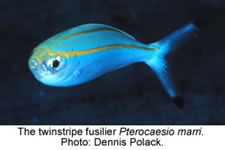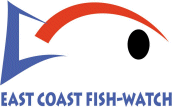

Conducted by

Sponsored by
East Coast Fish-Watch Project Report August, 2005
Find on this report:
PROGRESS AND NEW FINDINGS
New range extensions:
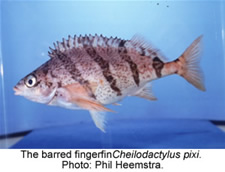 Guido Zsilavecz a keen naturalist, diver and photographer from Cape Town sent photos of 3 different specimens of the barred fingerfin, Cheilodactylus pixi, from False Bay. We have its range as Kynsna to Coffee Bay in our Coastal Fishes book. Guido says that it is frequently seen on offshore False Bay reefs in depths of about 20–25 m where it is more common than redfingers, Cheilodactylus fasciatus. He also observed barred fingerfins of ~25 cm TL, somewhat larger than the previously reported maximum of 18 cm TL.
Guido Zsilavecz a keen naturalist, diver and photographer from Cape Town sent photos of 3 different specimens of the barred fingerfin, Cheilodactylus pixi, from False Bay. We have its range as Kynsna to Coffee Bay in our Coastal Fishes book. Guido says that it is frequently seen on offshore False Bay reefs in depths of about 20–25 m where it is more common than redfingers, Cheilodactylus fasciatus. He also observed barred fingerfins of ~25 cm TL, somewhat larger than the previously reported maximum of 18 cm TL.
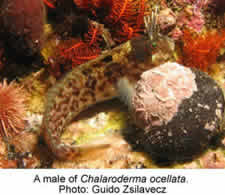 Guido also photographed some blennies in False Bay that he did not recognise. The small colony of ~6–8 blennies was using empty giant barnacle (Austromegabalanus cylindricus) shells as home, with a few blennies swimming freely nearby. One photo showed a male guarding eggs. He did not peek out at all but rather kept well inside the barnacle! One female with short orbital tentacles and a swollen belly was obviously full of eggs; while other fish (males?) had long orbital tentacles. Phil saw swellings on the anterior anal fin rays that he said are characteristic of males of some blenny species. We sent the images to blenny expert, Jeff Williams, at the Smithsonian Institute. He was unable to identify the species but said, “Phil is right about the ‘fleshy rugosities’ as blenny taxonomists call them. They are present on the anal-fin spines (and at the tips of the segmented anal-fin rays of some blennies) of mature males of most species in the blenny tribe Blenniini. As Phil mentioned, it would be great to catch a few specimens to identify the species. Jeff also congratulated Guido on his excellent photographs. This species was identified as Chalaroderma ocellata which is known from Saldanha Bay to Port Alfred. The photographs will be used as a colour source for our next book and we also welcome Guido’s observations about this species and will use them to supplement the species description.
Guido also photographed some blennies in False Bay that he did not recognise. The small colony of ~6–8 blennies was using empty giant barnacle (Austromegabalanus cylindricus) shells as home, with a few blennies swimming freely nearby. One photo showed a male guarding eggs. He did not peek out at all but rather kept well inside the barnacle! One female with short orbital tentacles and a swollen belly was obviously full of eggs; while other fish (males?) had long orbital tentacles. Phil saw swellings on the anterior anal fin rays that he said are characteristic of males of some blenny species. We sent the images to blenny expert, Jeff Williams, at the Smithsonian Institute. He was unable to identify the species but said, “Phil is right about the ‘fleshy rugosities’ as blenny taxonomists call them. They are present on the anal-fin spines (and at the tips of the segmented anal-fin rays of some blennies) of mature males of most species in the blenny tribe Blenniini. As Phil mentioned, it would be great to catch a few specimens to identify the species. Jeff also congratulated Guido on his excellent photographs. This species was identified as Chalaroderma ocellata which is known from Saldanha Bay to Port Alfred. The photographs will be used as a colour source for our next book and we also welcome Guido’s observations about this species and will use them to supplement the species description.
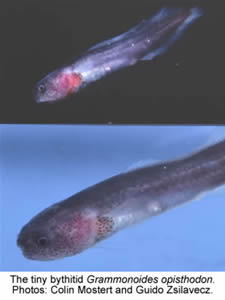 Another set of images by Guido Zsilavecz and Colin Mostert show the tiny bythitid, Grammonus opisthodon (SSF 98.8) a rare viviparous fish, which was previously known from 2 specimens collected off Storms River and Port Alfred. These photos will allow us to include live colour details for this species in our next fish book.
Another set of images by Guido Zsilavecz and Colin Mostert show the tiny bythitid, Grammonus opisthodon (SSF 98.8) a rare viviparous fish, which was previously known from 2 specimens collected off Storms River and Port Alfred. These photos will allow us to include live colour details for this species in our next fish book.
Georgina Jones, also from Cape Town, sent a photo of a ghost pipefish from False Bay. Kate Moots, an American ichthyologist who has just completed a year-long postdoctoral fellowship at SAIAB, working on pipefishes (Family Syngnathidae) and the ghost pipefish family, Solenostomidae, wrote: Indeed your photo is of a ghost pipefish and, regardless of the species, it is an extension of the distribution these tropical fish. The individual is a young one that has recently moved from being planktonic to taking up life on the reef. The difficulty comes when I try to identify it to species from the photo. Recent works on ghost pipefish focus on museum specimens that no longer show any colour pattern. In addition, as the fish grow, they often change their shape considerably. The features that have been used to identify ghost pipefish are mostly things like body proportions, fin ray counts, and patterns and distributions of spines on the body. Unfortunately, these are rarely (if ever) visible on even the best underwater photos. With all of that as a cautionary introduction, I would tentatively consider your image a juvenile of Solenostomus paradoxus (or slightly less likely, a juvenile Solenostomus cyanopterus). My tentative ID is Solenostomus paradoxus (often called the ornate ghost pipefish) because of the white tips of the tail- (and to a lesser extent of the dorsal- and pelvic-) fin rays that extend far beyond the margin of the fin membrane and the pale extensions (skin flaps) elsewhere on the body. In addition, this individual is semi-transparent with a complex “mottling” of red all over the body and fins. None of these features are common for Solenostomus cyanopterus.
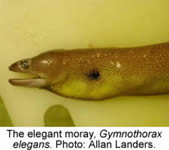 The elegant moray, Gymnothorax elegans, was recently collected from Landers Reef off Park Rynie in 40 m by Allan Connell. This rare deep-water moray is another new record for South Africa. Previously known from 30 to 100 m off Inhaca, Réunion Mauritius and the Maldives to the Hawaiian, Society and Samoa Ids.
The elegant moray, Gymnothorax elegans, was recently collected from Landers Reef off Park Rynie in 40 m by Allan Connell. This rare deep-water moray is another new record for South Africa. Previously known from 30 to 100 m off Inhaca, Réunion Mauritius and the Maldives to the Hawaiian, Society and Samoa Ids.
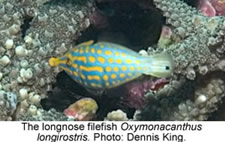 The longnose filefish Oxymonacanthus longirostris was recently found in a large area of staghorn coral at about 15 m on Two-Mile Reef, Sodwana Bay. Neville Ayliffe spotted it and Dennis King took the photo. Neither had seen this fish at Sodwana before. Is this a new sighting they asked? It certainly is - and a new record for South Africa! Previously this Indo-West Pacific species was known south to Maputo.
The longnose filefish Oxymonacanthus longirostris was recently found in a large area of staghorn coral at about 15 m on Two-Mile Reef, Sodwana Bay. Neville Ayliffe spotted it and Dennis King took the photo. Neither had seen this fish at Sodwana before. Is this a new sighting they asked? It certainly is - and a new record for South Africa! Previously this Indo-West Pacific species was known south to Maputo.
The twinstripe fusilier Pterocaesio marri was photographed at Sodwana Bay by Dennis Polack. This is a new record for southern Africa. This fusilier is known from Kenya, Tanzania, Chagos, Comoros, Seychelles, Mauritius and Réunion and is often misidentified as the similar double-lined fusilier Pterocaesio digramma. Both have black tips to their tail-fin lobes and two narrow yellow stripe son the body. In the twinstripe fusilier the top of the lower strip touches the lateral line (LL) for most of its length whereas the double-lined fusilier has its lower yellow stripe starting a scale row below the lateral line and only touches the LL where it crosses it below the soft dorsal fin. The three-stripe fusilier, Pterocaesio trilineata was also photographed at Sodwana Bay by Dennis, a new record for Africa. These photographs are being used by Elaine Heemstra as colour sources for a colour plate of western Indian Ocean fusiliers.
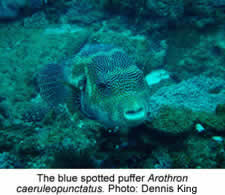 Neville also attached some pictures of unusual fish he had seen lately. ‘Firstly the blue spotted puffer Arothron caerulopunctatus – has this been spotted in South Africa? It was huge!! About 80 cm, judging from the size of the snappers in the background’. Neville continued ‘Secondly, is this A. mappa or A caerulopunctatus or a hybrid? Arothron mappa has a star around the eyes and curved squiggles, caerulopunctatus has circles around the eyes and blue spots and stellatus has black spots and no stars around the eyes. This seems to be a combination of all three? We sent these images to Keiichi Matsuura, the pufferfish fundi in Japan, and he identified them both as an Indo-central Pacific species, the blue spotted puffer Arothron caerulopunctatus. This is a new record for Africa! The blue spotted puffer was previously known from Maldives and Réunion in the western Indian Ocean.
Neville also attached some pictures of unusual fish he had seen lately. ‘Firstly the blue spotted puffer Arothron caerulopunctatus – has this been spotted in South Africa? It was huge!! About 80 cm, judging from the size of the snappers in the background’. Neville continued ‘Secondly, is this A. mappa or A caerulopunctatus or a hybrid? Arothron mappa has a star around the eyes and curved squiggles, caerulopunctatus has circles around the eyes and blue spots and stellatus has black spots and no stars around the eyes. This seems to be a combination of all three? We sent these images to Keiichi Matsuura, the pufferfish fundi in Japan, and he identified them both as an Indo-central Pacific species, the blue spotted puffer Arothron caerulopunctatus. This is a new record for Africa! The blue spotted puffer was previously known from Maldives and Réunion in the western Indian Ocean.
Neville continued ‘Has the S. frenatus (bridled parrotfish) been spotted here and is the other parrot an initial phase Hipposcarus harid ?’ We have seen the bridled parrotfish at Sodwana, but this photograph documents the record. This species is not in Smiths’ Sea Fishes and was not previously known from our area. The other fish was not the longnose parrot, Hipposcarus harid, but an initial phase bridled parrot.
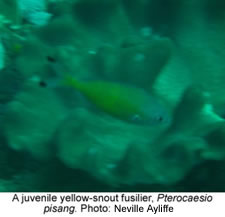 ‘Lastly, what fusilier is this?’ (The photo is badly out of focus, but it shows a fish about 15cm long, green with a black spot on the tip of each tail fin lobe.) ‘Is it a juvenile lunaris?’ asked Neville. This is a juvenile yellow-snout fusilier, Pterocaesio pisang. This fusilier was not known from South Africa until it was spotted by Neville at Sodwana Bay. He pointed out some yellow-snout fusiliers shoaling with other fusiliers when we dived with him earlier this year.
‘Lastly, what fusilier is this?’ (The photo is badly out of focus, but it shows a fish about 15cm long, green with a black spot on the tip of each tail fin lobe.) ‘Is it a juvenile lunaris?’ asked Neville. This is a juvenile yellow-snout fusilier, Pterocaesio pisang. This fusilier was not known from South Africa until it was spotted by Neville at Sodwana Bay. He pointed out some yellow-snout fusiliers shoaling with other fusiliers when we dived with him earlier this year.
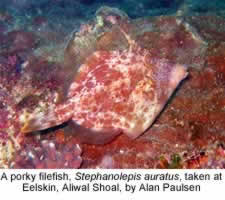 John Dench from Kloof sent us two photos of a porky filefish, Stephanolepis auratus, taken at Eelskin, Aliwal Shoal, by Alan Paulsen, to confirm its identification. The images were taken approximately 30 seconds apart, with the shot from the rear taken first. It was interesting that the colour of the fish appeared different in the two shots, so we sent the images to Barry Hutchins the Australian filefish expert. He exclaimed ‘What a great shot of a female Stephanolepis auratus! All of the other underwater shots I have of this species are of males. The reddish colour of the fish is obviously to match the background (as many filefish do).
John Dench from Kloof sent us two photos of a porky filefish, Stephanolepis auratus, taken at Eelskin, Aliwal Shoal, by Alan Paulsen, to confirm its identification. The images were taken approximately 30 seconds apart, with the shot from the rear taken first. It was interesting that the colour of the fish appeared different in the two shots, so we sent the images to Barry Hutchins the Australian filefish expert. He exclaimed ‘What a great shot of a female Stephanolepis auratus! All of the other underwater shots I have of this species are of males. The reddish colour of the fish is obviously to match the background (as many filefish do).

Henry Oosthuizen sent a photo of a rare shortsnout lancetfish, Alepisaurus brevirostris, caught 40 miles off Shelly Beach, KZN. It was 82 cm TL and weighed 1.7kg. In Smiths’ Sea Fishes this species is reported from all major oceans, but only one South African specimen from off Algoa Bay has previously been recorded of this species.
’The oblique banded butterflyfish, Chaetodon mitratus is often found along deep outer reef walls, usually from 40 m to at least 80 m. It is rarely seen because of this depth preference but recently (2005) it was photographed at 45 m at Sodwana Bay by Kerry Sink. This is a new record for South Africa. This fish is solitary or found in pairs, rarely seen in small groups. It is reported to feed on small invertebrates, zooplankton and algae and attains 12 cm. In the Western Indian Ocean it is known from Sodwana Bay, southern Mozambique (where it was photographed at Morrungulu by Dennis King), Chagos, Maldives, Mauritius, and Réunion. A separate population which differs slightly in colour pattern is known from Cocos-Keeling Atoll and Christmas Island in the Eastern Indian Ocean.
TWO NEW WORKSHEETS
We have produced two new underwater worksheets: Worksheet No. 12 shows the 13 species of goatfish (Family Mullidae) known from southern Africa. Worksheet No. 13 shows 19 of the 43 species of seabream (Family Sparidae) found in our area. The colour reproduction of these two new worksheets is inferior to our previous worksheets, and this will be the last of our waterproof underwater worksheets. Future worksheets will be printed on ordinary paper with a much better colour rendition.
All of our previous waterproof worksheets are still available. These are as follows (to view them click here:
- No. 1: Southern African Butterfly-fishes: Family Chaetodontidae
- No. 2: Southern African Angelfishes: Family Pomacanthidae
- No. 3: Southern African Reef Fishes: Part 1.
- No. 4: Fishes of the Eastern Cape Province
- No. 5: Southern African Trigger-fishes: Family Balistidae
- No. 6: Southern African Wrasses: Family Labridae (Part 1)
- No. 7: Southern African Rockcods (Groupers) Family Serranidae – Part 1, Subfamily Epinephelinae
- No. 8: Southern African Hawkfish (Cirrhitidae) and Fingerfins (Cheilodactylidae)No. 9: Fishes of Aliwal Shoal, Part 1.
- No. 10: Southern African Sharks – Part 1
- No. 11: Southern African Wrasses: Family Labridae (Part 2)
- No. 12: Southern African Goatfish (Family Mullidae)
- No. 13: Southern African Seabream (Sparids) – Part 1
PRICES
Worksheets 1-3: R10 each.
Worksheets 4-13: R 20 each
Please add R5.00 for postage.
Send your order to East Coast Fish Watch, SAIAB, Private Bag 1015, Grahamstown 6140
FIELD TRIP
 Dear Fish-Watchers, We have a new man helping us with the East Coast Fish-Watch Project: Phanor Montoya-Maya. Phanor and his wife Jessica Escobar ... recently arrived from Colombia. She is working on an M.Sc. project studying catsharks (Family Scyliorhinidae) in the Department of Ichthyology and Fisheries Science at Rhodes University. Phanor is a marine biologist and a keen diver who is eager to learn and teach about South African marine fishes. He has lots of experience working with divers in the Caribbean and is enthusiastic about developing the outreach / educational activities of our East Coast Fish Watch Project. Phanor is now running our website, and he will be organizing Fish-Watch dives and short courses in fish identification.
Dear Fish-Watchers, We have a new man helping us with the East Coast Fish-Watch Project: Phanor Montoya-Maya. Phanor and his wife Jessica Escobar ... recently arrived from Colombia. She is working on an M.Sc. project studying catsharks (Family Scyliorhinidae) in the Department of Ichthyology and Fisheries Science at Rhodes University. Phanor is a marine biologist and a keen diver who is eager to learn and teach about South African marine fishes. He has lots of experience working with divers in the Caribbean and is enthusiastic about developing the outreach / educational activities of our East Coast Fish Watch Project. Phanor is now running our website, and he will be organizing Fish-Watch dives and short courses in fish identification.
Please keep your photos, queries, comments, and suggestions coming in. We are always happy to hear from you.
Best regards, Phil, Elaine and Phanor.

